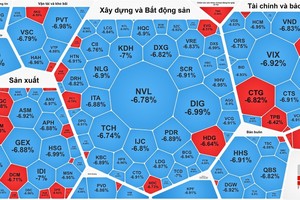 Boats on the Sai Gon River
Boats on the Sai Gon River
The city has currently 92 local canal and river routes featuring a total length of 598.7 kilometers and five national inland waterways with a length of more than 100 kilometers. There are trans-provincial routes, fairways connecting the city and seaports, and tourist and passenger transport systems, creating an inland waterway transport network linking with the Southern Key Economic Region, connecting international transportation and economy.
HCMC has many waterways linking the city with Southern provinces and cities, such as HCMC-Ca Mau/Ha Tien route starting in HCMC and running through canals of Te, Doi, Ong Lon, Cay Kho, Ba Lao, Can Giuoc River, Nuoc Man canal, Vam Co River, Cho Gao canal, Sa Dec City in Dong Thap Province, Hau Giang River, Soi canal, Rach Gia canal, Ha Tien City, Ba Hon canal and Kien Luong town with a total length of about 320 kilometers.
Routes between HCMC and localities of the southeast region, such as Bien Hoa and Binh Duong run through rivers of Sai Gon and Dong Nai.
 River bus in HCMC
River bus in HCMC
The city has a great potential to develop its inland waterway transport that can help reduce transportation cost, create competitiveness of domestic commodities, carry a large quantity of goods and oversized/overweight cargo and prevent environmental pollution.
Although natural river and water conditions have many advantages, private transportation means still see a lack of conditions for development. At present, the city has 92 transportation companies featuring 308 means of waterway transport, including high-speed boats, touring canoes, floating restaurants, passenger boats, ferries and others.
The number of new means of waterway transport registered in 2020 was 267 while the figure in 2021 was 229. While the waterway transport means that are operating in the city is 50
However, the city’s system of inland waterways is facing lack of facilities like a fully planned waterway networt, harbors, stopovers for tourists and land fund for services along the sides of canals and rivers.
The Department of Transport has strengthened Information Technology application in the management of waterway activities; built GIS (Geographic Information Systems) database about waterway infrastructure and softwares serving for the management, operation of inland waterway transport and provision of information to people through personal mobile devices; install security camera systems at intersection of rivers.
























